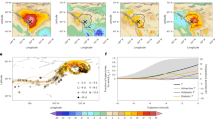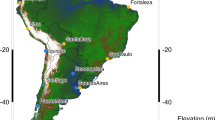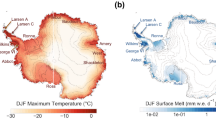Abstract
There has been an ostensibly large number of extreme weather events in the Northern Hemisphere mid-latitudes during the past decade1. An open question that is critically important for scientists and policy makers is whether any such increase in weather extremes is natural or anthropogenic in origin2,3,4,5,6,7,8,9,10,11,12,13. One mechanism proposed to explain the increased frequency of extreme weather events is the amplification of mid-latitude atmospheric planetary waves14,15,16,17. Disproportionately large warming in the northern polar regions compared with mid-latitudes—and associated weakening of the north–south temperature gradient—may favour larger amplitude planetary waves14,15,16,17, although observational evidence for this remains inconclusive18,19,20,21. A better understanding of the role of planetary waves in causing mid-latitude weather extremes is essential for assessing the potential environmental and socio-economic impacts of future planetary wave changes. Here we show that months of extreme weather over mid-latitudes are commonly accompanied by significantly amplified quasi-stationary mid-tropospheric planetary waves. Conversely, months of near-average weather over mid-latitudes are often accompanied by significantly attenuated waves. Depending on geographical region, certain types of extreme weather (for example, hot, cold, wet, dry) are more strongly related to wave amplitude changes than others. The findings suggest that amplification of quasi-stationary waves preferentially increases the probabilities of heat waves in western North America and central Asia, cold outbreaks in eastern North America, droughts in central North America, Europe and central Asia, and wet spells in western Asia.
This is a preview of subscription content, access via your institution
Access options
Subscribe to this journal
Receive 12 print issues and online access
$209.00 per year
only $17.42 per issue
Buy this article
- Purchase on Springer Link
- Instant access to full article PDF
Prices may be subject to local taxes which are calculated during checkout




Similar content being viewed by others
References
Coumou, D. & Rahmstorf, S. A decade of weather extremes. Nature Clim. Change 2, 491–496 (2012).
Rahmstorf, S. & Coumou, D. Increase of extreme events in a warming world. Proc. Natl Acad. Sci. USA 108, 17905–17909 (2011).
Dole, R. et al. Was there a basis for anticipating the 2010 Russian heat wave? Geophys. Res. Lett. 38, L06702 (2011).
Otto, F. E. L., Massey, N., van Oldenborgh, G. J., Jones, R. G. & Allen, M. R. Reconciling two approaches to attribution of the 2010 Russian heat wave. Geophys. Res. Lett. 39, L04702 (2012).
Trenberth, K. E. & Fasullo, J. Climate extremes and climate change: The Russian heat wave and other climate extremes of 2010. J. Geophys. Res. 117, D17103 (2012).
Peterson, T. C., Stott, P. A. & Herring, S. Explaining extreme events of 2011 from a climate perspective. Bull. Am. Meteorol. Soc. 93, 1041–1067 (2012).
Peterson, T. C., Hoerling, M. P., Stott, P. A. & Herring, S. C. Explaining extreme events of 2012 from a climate perspective. Bull. Am. Meteorol. Soc. 94, S1–S74 (2013).
Stott, P. A., Stone, D. A. & Allen, M. R. Human contribution to the European heatwave of 2003. Nature 432, 610–614 (2004).
Zwiers, F. W., Zhang, X. & Feng, Y. Anthropogenic influence on long return period daily temperature extremes at regional scales. J. Clim. 24, 881–892 (2011).
Pall, P. et al. Anthropogenic greenhouse gas contribution to flood risk in England and Wales in autumn 2000. Nature 470, 382–385 (2011).
Min, S-K., Zhang, X., Zwiers, F. W. & Hegerl, G. C. Human contribution to more-intense precipitation extremes. Nature 470, 378–381 (2011).
Hansen, J., Sato, M. & Ruedy, R. Perception of climate change. Proc. Natl Acad. Sci. USA 109, 14726–14727 (2012).
Field, C. B.et al. (eds) Managing the Risks of Extreme Events and Disasters to Advance Climate Change Adaptation (Cambridge Univ. Press, 2012).
Francis, J. A. & Vavrus, S. J. Evidence linking Arctic amplification to extreme weather in mid-latitudes. Geophys. Res. Lett. 39, L06801 (2012).
Tang, Q., Zhang, X. & Francis, J. A. Extreme summer weather in northern mid-latitudes linked to a vanishing cryosphere. Nature Clim. Change 4, 45–50 (2014).
Liu, J., Curry, J. A., Wang, H., Song, M. & Horton, R. M. Impact of declining Arctic sea ice on winter snowfall. Proc. Natl Acad. Sci. USA 109, 4074–4079 (2012).
Petoukhov, V., Rahmstorf, S., Petri, S. & Schellnhuber, H. J. Quasiresonant amplification of planetary waves and recent Northern Hemisphere weather extremes. Proc. Natl Acad. Sci. USA 110, 5336–5341 (2013).
Screen, J. A. & Simmonds, I. Exploring links between Arctic amplification and mid-latitude weather. Geophys. Res. Lett. 40, 959–964 (2013).
Screen, J. A. & Simmonds, I. Caution needed when linking weather extremes to amplified planetary waves. Proc. Natl Acad. Sci. USA 110, E2327 (2013).
Barnes, E. A. Revisiting the evidence linking Arctic amplification to extreme weather in midlatitudes. Geophys. Res. Lett. 40, 4728–4733 (2013).
Wallace, J. M., Held, I. M., Thompson, D. W. J., Trenberth, K. E. & Walsh, J. E. Global warming and winter weather. Science 343, 729–730 (2014).
Leiserowitz, A., Maibach, E., Roser-Renouf, C., Feinberg, G. & Howe, P. Extreme Weather and Climate Change in the American Mind (Yale Univ. and George Mason Univ., 2012).
Screen, J. A. & Simmonds, I. The central role of diminishing sea ice in recent Arctic temperature amplification. Nature 464, 1334–1337 (2010).
Serreze, M. C. & Barry, R. G. Processes and impacts of arctic amplification: A research synthesis. Glob. Planet. Change 77, 85–96 (2011).
Hoskins, B. J. & Karoly, D. J. The steady linear response of a spherical atmosphere to thermal and orographic forcing. J. Atmos. Sci. 38, 1179–1196 (1981).
Teng, H., Branstator, G., Wang, H., Meehl, G. A. & Washington, W. M. Probability of US heat waves affected by a subseasonal planetary wave pattern. Nature Geosci. 6, 1056–1061 (2013).
Jones, P. D. et al. Hemispheric and large-scale land surface air temperature variations: An extensive revision and an update to 2010. J. Geophys. Res. 117, D05127 (2012).
Adler, R. F. et al. The Version 2 Global Precipitation Climatology Project (GPCP) monthly precipitation analysis (1979–Present). J. Hydrometeor. 4, 1147–1167 (2003).
Dee, D. P. et al. The ERA-Interim reanalysis: Configuration and performance of the data assimilation system. Q. J. R. Meteorol. Soc. 137, 553–597 (2011).
Moser, B. K. & Stevens, G. R. Homogeneity of variance in the two-sample means test. Am. Stat. 46, 19–21 (1992).
Acknowledgements
CRUTEM4 data were provided by the UK Met Office Hadley Centre (www.metoffice.gov.uk/hadobs); GPCP data by the NOAA Earth System Research Laboratory (www.esrl.noaa.gov/psd/data); and ERA-Interim data by the ECMWF (apps.ecmwf.int/datasets/). This research was funded by UK Natural Environment Research Council grant NE/J019585/1 awarded to J.A.S.
Author information
Authors and Affiliations
Contributions
J.A.S. designed and performed the research, analysed data and wrote the paper. I.S. discussed the results and commented on the manuscript.
Corresponding author
Ethics declarations
Competing interests
The authors declare no competing financial interests.
Supplementary information
Rights and permissions
About this article
Cite this article
Screen, J., Simmonds, I. Amplified mid-latitude planetary waves favour particular regional weather extremes. Nature Clim Change 4, 704–709 (2014). https://doi.org/10.1038/nclimate2271
Received:
Accepted:
Published:
Issue Date:
DOI: https://doi.org/10.1038/nclimate2271
This article is cited by
-
Response of winter climate and extreme weather to projected Arctic sea-ice loss in very large-ensemble climate model simulations
npj Climate and Atmospheric Science (2024)
-
Drought projections for the NW Iberian Peninsula under climate change
Climate Dynamics (2024)
-
Risks of synchronized low yields are underestimated in climate and crop model projections
Nature Communications (2023)
-
A methodology for attributing severe extratropical cyclones to climate change based on reanalysis data: the case study of storm Alex 2020
Climate Dynamics (2023)
-
Region-dependent meteorological conditions for the winter cold hazards with and without precipitation in China
Natural Hazards (2023)



